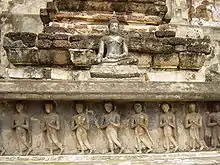Samāpatti
Samāpatti (Sanskrit; Pali; traditional Chinese: 三摩跋提; ; pinyin: sānmóbátí) is a common term in Buddhism and Hindu Yoga, frequently used as a synonym for samādhi.

| Part of a series on |
| Buddhism |
|---|
 |
|
Etymology
Samāpatti stands for correct (samyag) acquisition (āpatti) of Truth. It is a form of alaukika-pratyakṣa (extraordinary perception) forming thus a legitimate part of the perceptual (pratyakṣa) instruments of adequate knowledge (pramāṇa).
Buddhism
In Buddhism, samapatti refers to the four attainments (the realm of the infinity of space, realm of the infinity of consciousness, realm of nothingness, realm of neither consciousness nor unconsciousness). As per the suttas the samapattis are of a different nature than the four jhānas (i.e. samadhi the eighth component of the eightfold path). The samapatti are not part of the path and are not known to be of any use for realising nibbana.The Buddha in MN 26 The Noble Search sutta (Ariyapariyesana sutta) after having learned and mastered the samapattis with his two teachers decided to abandon them as he realised that "this teaching does not lead to disenchantment, to dispassion, to nibbana." By contrast, the Surangama Sutra mentions samapatti 26 times, with a positive instruction in their practice.
Pātañjala Yoga
In the Yoga Sutras of Patanjali, samāpatti is discussed as the universal form of the Yoga called samprajñāta-samadhi, or savikalpa samadhi, followed by asamprajñāta-samadhi, or nirvikalpa samadhi. It has as its prerequisite the annihilation of all (non-sattvic) modifications (vṛtti) of mind (citta).[1]
See also
References
Sources
Printed sources
- Whicher, Ian (1998), The Integrity of the Yoga Darsana: A Reconsideration of Classical Yoga, SUNY Press